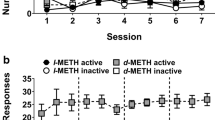Summary
A variety of drugs including anticholinergics, antihistamines, MAO inhibitors, miscellaneous stimulants and depressants (“tranquilizers”), and imipramine-like compounds were tested in rats conditioned to respond in the Sidman, continuous avoidance procedure. Several doses of each drug were tested to determine the minimum effective dose that increased (stimulated) or decreased (depressed) the rate of lever pressing. Behaviorally inactive doses of each drug were then tested in three drug interaction experiments: 1) amphetamine potentiation, 2) cocaine potentiation, 3) stimulation with a nondepressant dose of tetrabenazine.
Pretreatment with imipramine-like compounds or cocaine produced stimulation in all three drug interaction experiments. Promethazine, tyramine, guanethidine, as well as a few anticholinergics, and MAO inhibitors potentiated amphetamine and cocaine, but did not stimulate with tetrabenazine. Chlorpromazine, azacyclonol, methylphenidate, phenindamine, and promazine were inactive in the three drug interaction tests.
Imipramine-like drugs differed qualitatively from all other agents tested in that they had no systematic effects when given alone, but consistently produced stimulation when combined with a small, nondepressant dose of tetrabenazine. A comparison of the present behavioral data with previous biochemical findings indicates that imipramine induces a stimulant (or antidepressant) effect by increasing the reactivity of central mechanisms to the action of “free” norepinephrine.
Similar content being viewed by others
References
Axelrod, J., G. Hertting and L. Potter: Effect of drugs on the uptake and release of 3H-Norepinephrine in the rat heart. Nature (Lond.) 194, 297 (1962).
Besendorf, H., u. A. Pletscher: Beeinflussung zentraler Wirkungen von Reserpin und 5-Hydroxytryptamin durch Isonicotinsäurehydrazide. Helv. physiol. pharmacol. Acta 14, 383–390 (1956).
Brodie, B., P. Dick, P. Kielholz, W. Pöldinger and W. Theobald: Preliminary pharmacological and clinical results with desmethylimipramine (DMI) G35020, a metabolite of imipramine. Psychopharmacologia (Berl.) 2, 467–474 (1961).
—, A. Pletscher and P. A. Shore: Possible role of serotonin in brain function and in reserpine action. J. Pharmacol. exp. Ther. 116, 9 (1956).
Carlton, P. L.: Potentiation of the behavioral effects of amphetamine by imipramine. Psychopharmacologia (Berl.) 2, 364–376 (1961a).
—: Augmentation of the behavioral effects of amphetamine by scopolamine. Psychopharmacologia (Berl.) 2, 377–380 (1961b).
—, and Pauline Didamo: Augmentation of the behavioral effects of amphetamine by atropine. J. Pharmacol. exp. Ther. 132, 91–96 (1961).
-, and Z. P. Horovitz: Behavioral and EEG effects of atropine and methyl atropine. Paper read at meeting of Eastern Psychological Assn., April 1961.
Costa, E., G. L. Gessa, C. Hirsch, R. Kuntzman and B. B. Brodie: On current status of serotonin as a brain neurohormone and in action of reserpinelike drugs. Ann. N.Y. Acad. Sci. 96, 118–131 (1962).
Friend, D. G.: The metabolism of dihydroxyphenylalanine in man before and after administration of psychotropic drugs. Ann. N.Y. Acad. Sci. 96, 152–159 (1962).
Garattini, S., A. Giachetti, A. Jori, L. Pieri and L. Valzelli. Effect of imipramine, amitriptyline and their monomethyl derivatives on reserpine activity. J. Pharm. Pharmacol. 14, 509–514 (1962).
Goodman, L. S., and A. Gilman: The pharmacological basis of therapeutics, 2nd ed. New York: Macmillan 1956.
Heise, G. A.: Behavioral analysis of tetrabenazine in animals. Dis. nerv. Syst. 21 (Suppl.) 1–4 (1960).
—, and E. Boff: Behavioral determination of time and dose parameters of monoamine oxidase inhibitors. J. Pharmacol. exp. Ther. 129, 155–162 (1960).
— —: Continuous avoidance as a base-line for measuring behavioral effects of drugs. Psychopharmacologia (Berl.) 3, 264–282 (1962).
Hertting, G., J. Axelrod and R. W. Patrick: Actions of cocaine and tyramine on the uptake and release of [3H] Noradrenaline in the heart. Biochem. Pharmacol. 8, 346–347 (1961).
Kuhn, R.: Über die Behandlung depressiver Zustände mit einem Iminodibenzylderivat (G 22355). Schweiz. med. Wschr. 87, 1135–1140 (1957).
Pletscher, A.: Release of 5-hydroxytryptamine by benzoquinolizine derivatives with sedative action. Science 126, 507 (1957).
—, H. Besendorf u. H. P. Bächtold: Benzo[a]chinolizine, eine neue Körperklasse mit Wirkung auf den 5-Hydroxytryptamin- und Noradrenalin-Stoffwechsel des Gehirns. Naunyn-Schmiedebergs Arch. exp. Path. Pharmak. 232, 499–506 (1958).
Pulver, R., B. Exer u. B. Herrmann: Einige Wirkungen des N-(γ-Dimethylamino-propyl)-iminodibenzyl-HCl und seiner Metabolite auf den Stoffwechsel von Neurohormonen. Arzneimittel-Forsch. 10, 530–533 (1960).
Schaeppi, U.: Die Beeinflussung der Reizübertragung im peripheren Sympathicus durch Tofranil. Helv. physiol. pharmacol. Acta 18, 545–562 (1960).
Scheckel, C. L.: Interaction of antidepressants with amphetamine, cocaine, α-methyl-metatyrosine, and tetrabenazine. Fed. Proc. 22, 627 (1963).
Sidman, M.: Tactics of scientific research. Evaluating experimental data in psychology. New York: Basic Books 1960.
—: Avoidance conditioning with brief shock and no exteroceptive warning signal. Science 118, 157–158 (1953).
Sigg, E. B.: Pharmacological studies with Tofranil. Canad. psychiat. Ass. J. 4, 75 (1959).
—: The pharmacodynamics of imipramine. In: Psychosomatic medicine (Eds. J. H. Nodine and J. H. Moyer), pp. 671–678. Philadelphia: Lea & Febiger 1962.
Stein, L.: New methods for evaluating stimulants and antidepressants. In: Psychosomatic medicine (Eds. J. H. Nodine and J. H. Moyer), pp. 297–311. Philadelphia: Lea & Febiger 1962.
Sulser, F., J. Watts and B. B. Brodie: On the mechanism of antidepressant action of imipraminelike drugs. Ann. N.Y. Acad. Sci. 96, 279–288 (1962).
Vernier, V. G.: The pharmacology of antidepressant agents. Dis. nerv. Syst. 22 (Suppl.) 1–7 (1961).
Weissman, A.: Interaction effects of imipramine and d-amphetamine on nondiscriminated avoidance. Pharmacologist 3, 60 (1961).
Zbinden, G.: Pharmacodynamics of tetrabenazine and its derivatives. In: Psychosomatic medicine (Eds. J. H. Nodine and J. H. Moyer), pp. 443–454. Philadelphia: Lea & Febiger 1962a.
—: Reserpine antagonists and their effects on reserpine-induced catecholamine depletion of the rat adrenal medulla. Int. J. Neuropharmacol. 1, 435–445 (1962b).
Author information
Authors and Affiliations
Rights and permissions
About this article
Cite this article
Scheckel, C.L., Boff, E. Behavioral effects of interacting imipramine and other drugs with d-amphetamine, cocaine, and tetrabenazine. Psychopharmacologia 5, 198–208 (1964). https://doi.org/10.1007/BF00413242
Received:
Issue Date:
DOI: https://doi.org/10.1007/BF00413242




